Gastrointestinal Products Market Size 2025-2029
The gastrointestinal products market size is valued to increase by USD 5.38 billion, at a CAGR of 6.5% from 2024 to 2029. Rising prevalence of gastrointestinal disorders will drive the gastrointestinal products market.
Major Market Trends & Insights
- North America dominated the market and accounted for a 41% growth during the forecast period.
- By Type - Endoscopy devices segment was valued at USD 2.66 billion in 2023
- By End-user - Hospitals segment accounted for the largest market revenue share in 2023
Market Size & Forecast
- Market Opportunities: USD 75.89 million
- Market Future Opportunities: USD 5376.80 million
- CAGR from 2024 to 2029 : 6.5%
Market Summary
- The market encompasses a broad spectrum of offerings, including medications, medical devices, and diagnostic tools, designed to address a range of disorders affecting the gastrointestinal tract. One significant market trend is the increasing prevalence of gastrointestinal disorders, driven by factors such as aging populations, unhealthy diets, and sedentary lifestyles. This trend underpins the market's growth, with estimates suggesting a value of over USD 150 billion by 2026. Another key development shaping the market is the integration of artificial intelligence (AI) into endoscopic devices. AI-enabled tools offer enhanced diagnostic capabilities, enabling earlier and more accurate identification of gastrointestinal conditions. Regulatory compliance remains a challenge, as stringent regulations ensure the safety and efficacy of gastrointestinal products.
- Despite this, the market continues to evolve, with companies investing in research and development to bring innovative solutions to market. Overall, the market is poised for continued growth, driven by the rising burden of gastrointestinal disorders and technological advancements.
What will be the Size of the Gastrointestinal Products Market during the forecast period?
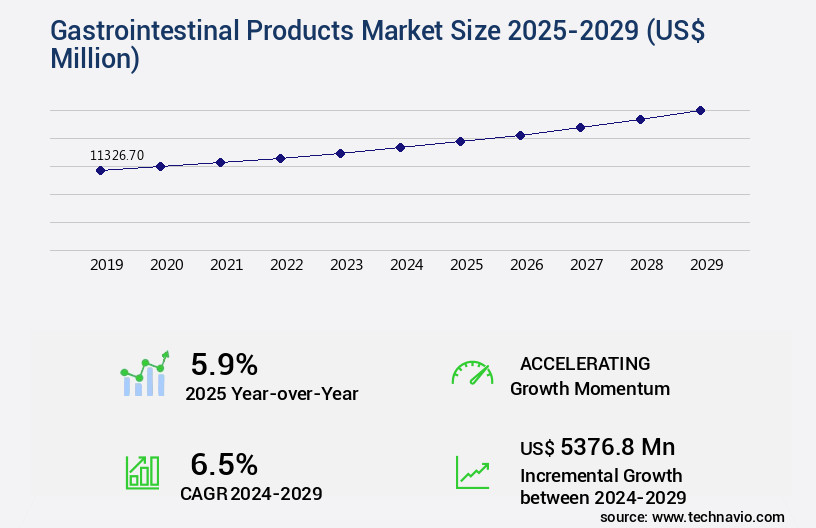
Get Key Insights on Market Forecast (PDF) Request Free Sample
How is the Gastrointestinal Products Market Segmented?
The gastrointestinal products industry research report provides comprehensive data (region-wise segment analysis), with forecasts and estimates in "USD million" for the period 2025-2029, as well as historical data from 2019-2023 for the following segments.
- Type
- Endoscopy devices
- Motility testing devices
- Ablation devices
- Biopsy devices
- Others
- End-user
- Hospitals
- Ambulatory surgical centers
- Others
- Geography
- North America
- Europe
- APAC
- China
- India
- Japan
- South Korea
- Rest of World (ROW)
By Type Insights
The endoscopy devices segment is estimated to witness significant growth during the forecast period.
The market encompasses a wide range of offerings, from diagnostic tools like endoscopy devices to functional foods and supplements, all aimed at promoting gut health and addressing various digestive discomforts. Endoscopy devices, such as gastroscopes and colonoscopies, play a pivotal role in GI diagnostics, enabling healthcare professionals to visualize the digestive tract and identify conditions like ulcers, tumors, inflammation, and even precancerous polyps. These minimally invasive procedures significantly improve patient outcomes, with colonoscopies reducing colorectal cancer mortality by up to 60% when performed regularly. Functional foods and supplements target specific digestive issues, such as lactose intolerance, bloating, and food sensitivities, by leveraging ingredients like probiotics, prebiotic fibers, and digestive enzymes.
Probiotic strains, such as Bifidobacterium and Lactobacillus, enhance gut microbiome health by promoting microbial diversity and immune system modulation. Synbiotic formulations, which combine probiotics and prebiotics, further optimize their efficacy. Prebiotic fibers, like inulin and oligofructose, serve as food for beneficial gut bacteria, fostering a healthy gut microbiota composition. Digestive enzymes, like amylase, protease, and lipase, aid in nutrient absorption and improve gi motility, ensuring optimal digestive function. Gut health markers, such as stool consistency and inflammatory markers, help assess overall gut health and monitor the effectiveness of various interventions. Metagenomic analysis and microbiome profiling offer valuable insights into the gut microbiota composition and its role in various health conditions, including irritable bowel syndrome, inflammatory bowel disease, and celiac disease.
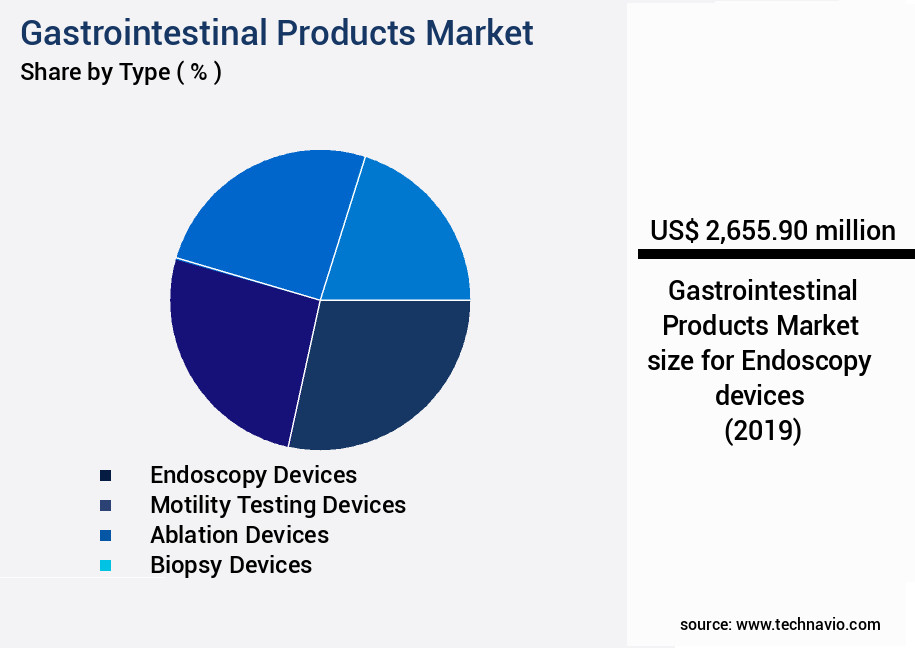
Request Free Sample
The Endoscopy devices segment was valued at USD 2.66 billion in 2019 and showed a gradual increase during the forecast period.
Fecal microbiota transplantation represents a novel therapeutic approach for restoring a healthy gut microbiome in patients with recurrent Clostridioides difficile infections. The continuous evolution of the GI Products Market reflects ongoing research and development efforts, with a focus on addressing unmet needs and improving patient outcomes. This includes the exploration of new probiotic strains, synbiotic formulations, and innovative delivery systems, as well as the integration of advanced technologies like AI and machine learning to enhance diagnostic accuracy and personalize treatment plans.
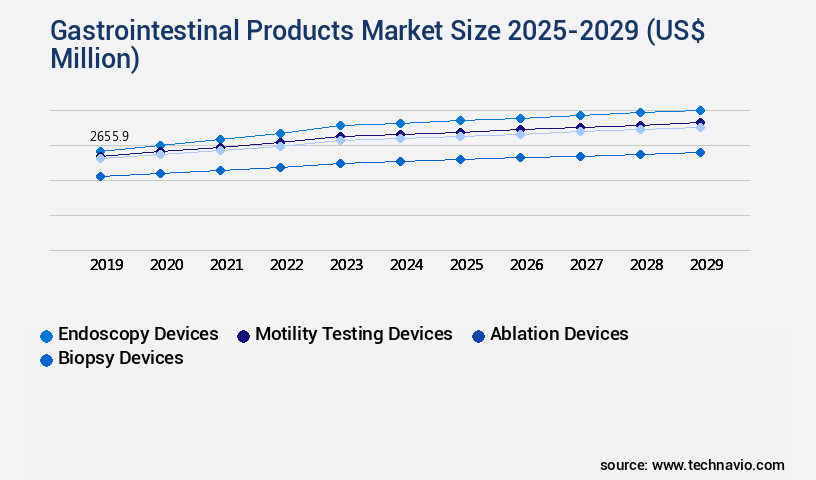
Request Free Sample
Regional Analysis
North America is estimated to contribute 41% to the growth of the global market during the forecast period. Technavio's analysts have elaborately explained the regional trends and drivers that shape the market during the forecast period.

See How Gastrointestinal Products Market Demand is Rising in North America Request Free Sample
The market in North America experiences significant growth due to a high prevalence of gastrointestinal (GI) disorders and an advanced healthcare infrastructure. Approximately 10-15% of the US population, equating to 25-45 million people, suffers from irritable bowel syndrome (IBS) (IFFGD). Colorectal cancer (CRC) is the third most common cancer diagnosis for both men and women, with an estimated 153,000 new cases annually.
This substantial incidence of GI disorders underscores the considerable demand for diagnostic and therapeutic GI products in the region. Furthermore, the aging population in North America contributes to market expansion. The robust healthcare sector and increasing awareness of GI disorders fuel the market's evolution.
Market Dynamics
Our researchers analyzed the data with 2024 as the base year, along with the key drivers, trends, and challenges. A holistic analysis of drivers will help companies refine their marketing strategies to gain a competitive advantage.
The market is experiencing significant growth due to the increasing awareness and concern for digestive health. Probiotic effects on gut microbiota and prebiotic impact on short-chain fatty acids have been at the forefront of research in this field. Probiotics, live bacteria and yeasts, help restore balance to the gut microbiome, improving gut microbiome diversity and immune function. Prebiotics, non-digestible fiber, selectively feed beneficial bacteria, enhancing their growth and activity. Intestinal permeability and inflammatory bowel disease (IBD) are major concerns in the gastrointestinal market. Probiotic supplementation and IBS symptoms have shown promising results in clinical trials, providing relief for those suffering from IBD. The impact of prebiotics on gut microbiota composition has also been studied extensively, with prebiotic fiber shown to improve stool consistency and promote a healthier gut. Celiac disease and nutrient absorption are other key areas where gastrointestinal products play a crucial role. Functional foods and digestive health go hand in hand, with many products focusing on improving lactose intolerance through digestive enzyme activity. The gut-brain axis and mental well-being are also gaining attention, with research suggesting a link between gut health and mood. Fecal microbiota transplantation (FMT) for recurrent C. Difficile is a groundbreaking development in the gastrointestinal market. Metagenomic analysis of the gut microbiome in IBD provides valuable insights into the complex interactions between bacteria and the human body. The relationship between dietary fiber and gut health is well-established, with prebiotic fiber playing a critical role in maintaining gut barrier function. Short-chain fatty acids, produced by gut bacteria, have a significant impact on colon health. Probiotic strains and reduction of bloating are other benefits of gastrointestinal products, making them an essential part of a healthy lifestyle. GI transit time and prebiotic intake are also important factors influencing digestive discomfort and probiotic use. Overall, the market is poised for continued growth, driven by the increasing demand for natural solutions to digestive health concerns.
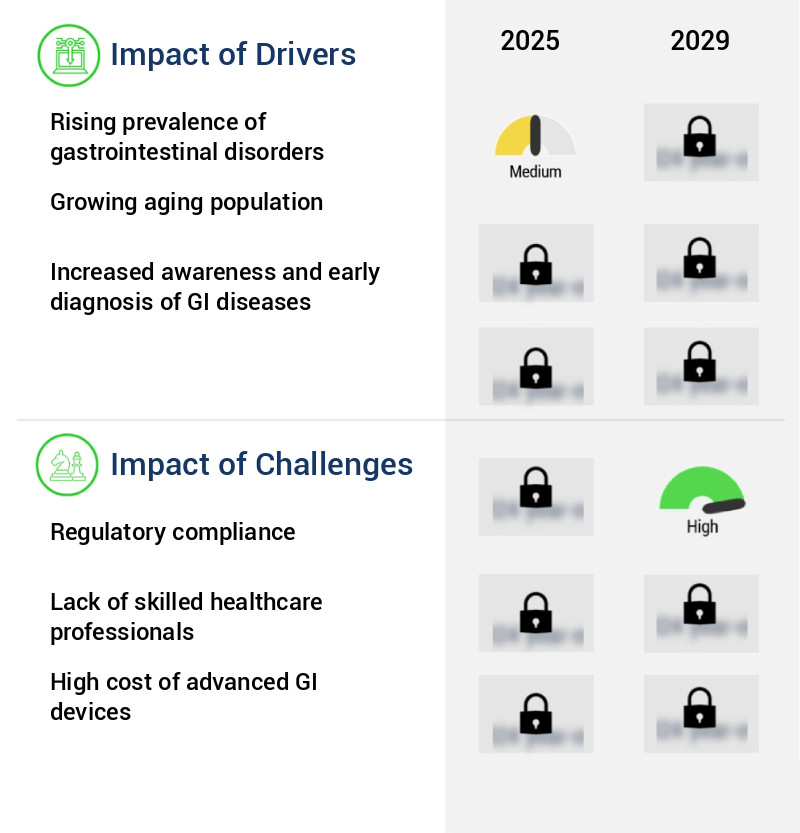
What are the key market drivers leading to the rise in the adoption of Gastrointestinal Products Industry?
- The escalating incidence of gastrointestinal disorders serves as the primary catalyst for market growth in this sector.
- The market is experiencing significant growth due to the increasing prevalence of gastrointestinal (GI) disorders. Conditions such as gastroesophageal reflux disease (GERD) and irritable bowel syndrome (IBS) are becoming more common, with IBS affecting around 25-45 million people in the US, equating to approximately 10%-15% of the population. This widespread prevalence underscores the need for effective diagnostic tools and treatments, driving the demand for GI products.
- GERD is another prevalent condition, impacting a substantial portion of the global population. The heightened demand for solutions to manage these conditions contributes to the robust growth of the market.
What are the market trends shaping the Gastrointestinal Products Industry?
- The integration of artificial intelligence into endoscopic devices is an emerging market trend. This advancement is set to revolutionize the medical field by enhancing diagnostic accuracy and improving procedural efficiency.
- The gastrointestinal (GI) products market is undergoing a significant transformation through the integration of artificial intelligence (AI) into endoscopic devices. This technological innovation is revolutionizing GI diagnostics by enhancing real-time image analysis, improving lesion detection, and facilitating polyp classification. For instance, Medtronic plc's latest offering, ColonPRO, is an advanced software for the GI Genius intelligent endoscopy system. This next-generation software, backed by an expanded dataset, boosts polyp detection accuracy by reducing false positives by approximately 9%.
- Furthermore, it introduces new procedural highlights, streamlining workflows and reducing administrative burdens for healthcare providers, thereby increasing overall efficiency. This trend underscores the potential of AI to revolutionize endoscopic procedures, leading to better patient outcomes.
What challenges does the Gastrointestinal Products Industry face during its growth?
- Compliance with regulatory requirements poses a significant challenge to the industry's growth trajectory. It is essential for businesses to adhere to these regulations to avoid penalties and ensure long-term success.
- The market encompasses a diverse range of devices and diagnostic tools used for the prevention, diagnosis, and treatment of gastrointestinal disorders. Regulatory compliance plays a pivotal role in this market, with manufacturers facing intricate and stringent regulations across various regions. In the US, the Food and Drug Administration (FDA) categorizes gastrointestinal devices into Class I, II, or III based on risk, with Class III devices necessitating Premarket Approval (PMA). Many endoscopic and motility testing devices require 510(k) clearance, demonstrating substantial equivalence to existing devices. Manufacturers must also adhere to the Quality System Regulation (QSR) under 21 CFR Part 820, ensuring proper design, manufacturing, and post-market surveillance.
- In the European Union, the Medical Device Regulation (MDR 2017/745) replaced the previous Medical Device Directive (MDD) in 2021, imposing more stringent safety, clinical data, and post-market surveillance requirements. With the increasing prevalence of gastrointestinal disorders and the growing demand for minimally invasive diagnostic and therapeutic solutions, the market for these products is expected to expand substantially.
Exclusive Technavio Analysis on Customer Landscape
The gastrointestinal products market forecasting report includes the adoption lifecycle of the market, covering from the innovator's stage to the laggard's stage. It focuses on adoption rates in different regions based on penetration. Furthermore, the gastrointestinal products market report also includes key purchase criteria and drivers of price sensitivity to help companies evaluate and develop their market growth analysis strategies.
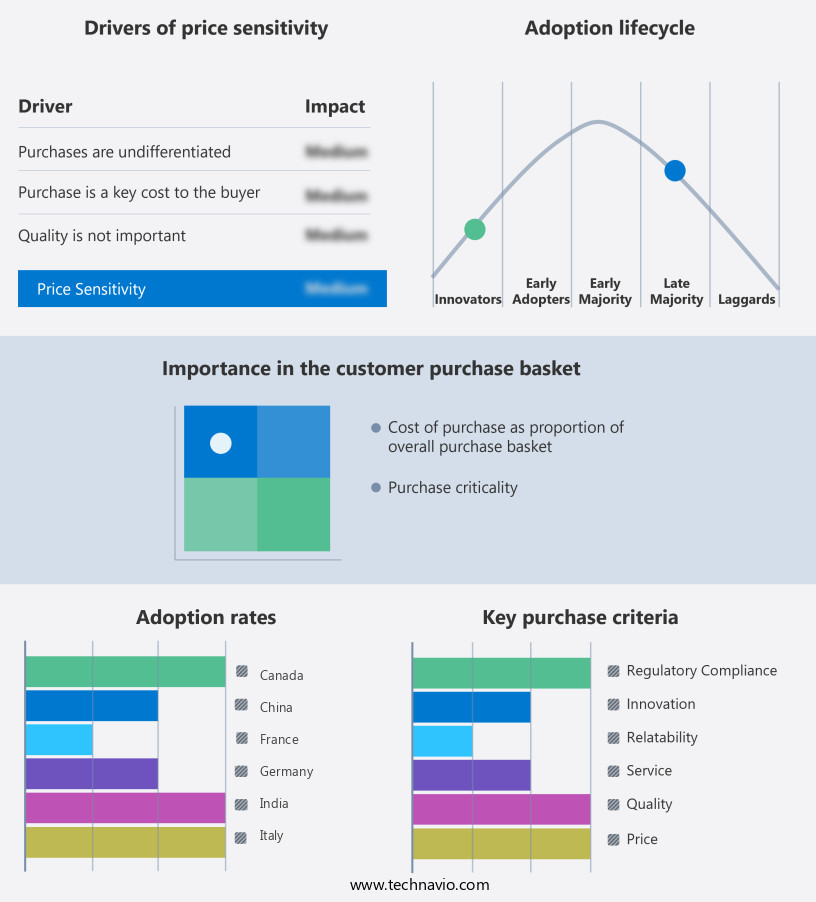
Customer Landscape of Gastrointestinal Products Industry
Competitive Landscape
Companies are implementing various strategies, such as strategic alliances, gastrointestinal products market forecast, partnerships, mergers and acquisitions, geographical expansion, and product/service launches, to enhance their presence in the industry.
Abbott Laboratories - The company specializes in gastrointestinal health solutions.
The industry research and growth report includes detailed analyses of the competitive landscape of the market and information about key companies, including:
- Abbott Laboratories
- ANGIPLAST Pvt. Ltd.
- Astellas Pharma Inc.
- Bayer AG
- Boston Scientific Corp.
- Dr Reddys Laboratories Ltd.
- FUJIFILM Holdings Corp.
- GlaxoSmithKline Plc
- GPC Medical Ltd.
- Johnson and Johnson
- Leinzett Medical
- Medtronic Plc
- MTW-Endoskopie W. Haag KG
- Mylan
- Nikotech Pvt. Ltd.
- Novartis AG
- Olympus Corp.
- Pfizer Inc.
- Santen Pharmaceutical Co. Ltd.
- Stryker Corp.
- Takeda Pharmaceutical Co. Ltd.
Qualitative and quantitative analysis of companies has been conducted to help clients understand the wider business environment as well as the strengths and weaknesses of key industry players. Data is qualitatively analyzed to categorize companies as pure play, category-focused, industry-focused, and diversified; it is quantitatively analyzed to categorize companies as dominant, leading, strong, tentative, and weak.
Recent Development and News in Gastrointestinal Products Market
- In January 2024, Takeda Pharmaceutical Company Limited announced the launch of its new gastrointestinal (GI) product, Entyvio, in South Korea. Entyvio is an integrin inhibitor indicated for the treatment of adults with moderately to severely active ulcerative colitis and Crohn's disease. According to Takeda's press release, the company expects this expansion to strengthen its presence in the Asian market (Takeda Pharmaceutical Company Limited, 2024).
- In March 2024, Pfizer Inc. and Alimentary Health, a leading Irish biotech company, entered into a strategic collaboration to develop and commercialize a novel microbiome-based therapeutic for GI disorders. The financial terms of the agreement were not disclosed in Pfizer's press release (Pfizer Inc., 2024).
- In April 2025, Allergan plc completed the acquisition of VirxImmune, a clinical-stage biotech company specializing in the development of novel immunotherapies for GI diseases. The deal, valued at approximately USD 1.3 billion, is expected to enhance Allergan's gastrointestinal portfolio and accelerate its research and development efforts (Allergan plc, 2025).
- In May 2025, the European Commission granted marketing authorization for Shire plc's Firazyr, an intravenous C1 inhibitor, for the treatment of acute attacks of hereditary angioedema (HAE) in adults and adolescents. This approval marks the first-ever intravenous C1 inhibitor for the treatment of HAE in Europe, expanding Shire's therapeutic offerings in the GI space (Shire plc, 2025).
Dive into Technavio's robust research methodology, blending expert interviews, extensive data synthesis, and validated models for unparalleled Gastrointestinal Products Market insights. See full methodology.
|
Market Scope
|
|
Report Coverage
|
Details
|
|
Page number
|
215
|
|
Base year
|
2024
|
|
Historic period
|
2019-2023 |
|
Forecast period
|
2025-2029
|
|
Growth momentum & CAGR
|
Accelerate at a CAGR of 6.5%
|
|
Market growth 2025-2029
|
USD 5376.8 million
|
|
Market structure
|
Fragmented
|
|
YoY growth 2024-2025(%)
|
5.9
|
|
Key countries
|
US, Germany, China, Japan, UK, France, Canada, Italy, South Korea, and India
|
|
Competitive landscape
|
Leading Companies, Market Positioning of Companies, Competitive Strategies, and Industry Risks
|
Request Free Sample
Research Analyst Overview
- The market continues to evolve, driven by growing consumer awareness and research into the intricacies of gut health. Short-chain fatty acids, produced by the gut microbiome, have emerged as key players in colon health and inflammatory bowel syndrome (IBS) management. Probiotic efficacy, a critical factor in gut health, is under constant scrutiny, with new probiotic strains and synbiotic formulations being developed to address lactose intolerance, bloating reduction, and digestive discomfort. The prevalence of food sensitivities and intestinal permeability issues has led to increased demand for functional foods and digestive enzymes. Metagenomic analysis and microbiome profiling are increasingly used to understand the gut microbiota composition and its role in gut barrier function, immune system modulation, and even the gut-brain axis.
- The market for gastrointestinal products is expected to grow at a robust pace, with industry analysts projecting a 10% annual increase in sales. For instance, a leading probiotic brand reported a 15% sales increase in the past year due to the introduction of a new probiotic strain specifically designed for IBS sufferers. This trend is reflective of the ongoing efforts to address the diverse needs of consumers and the continuous unfolding of market activities.
What are the Key Data Covered in this Gastrointestinal Products Market Research and Growth Report?
-
What is the expected growth of the Gastrointestinal Products Market between 2025 and 2029?
-
What segmentation does the market report cover?
-
The report is segmented by Type (Endoscopy devices, Motility testing devices, Ablation devices, Biopsy devices, and Others), End-user (Hospitals, Ambulatory surgical centers, and Others), and Geography (North America, Asia, Europe, and Rest of World (ROW))
-
Which regions are analyzed in the report?
-
What are the key growth drivers and market challenges?
-
Who are the major players in the Gastrointestinal Products Market?
-
Abbott Laboratories, ANGIPLAST Pvt. Ltd., Astellas Pharma Inc., Bayer AG, Boston Scientific Corp., Dr Reddys Laboratories Ltd., FUJIFILM Holdings Corp., GlaxoSmithKline Plc, GPC Medical Ltd., Johnson and Johnson, Leinzett Medical, Medtronic Plc, MTW-Endoskopie W. Haag KG, Mylan, Nikotech Pvt. Ltd., Novartis AG, Olympus Corp., Pfizer Inc., Santen Pharmaceutical Co. Ltd., Stryker Corp., and Takeda Pharmaceutical Co. Ltd.
Market Research Insights
- The market for gastrointestinal products is a dynamic and continually evolving industry, with a focus on delivering nutritional value and therapeutic benefits to consumers. Two key statistics illustrate the market's growth and significance. First, sales of gastrointestinal products in the United States have experienced a steady increase of approximately 5% annually over the past decade. Second, industry experts anticipate that this trend will continue, with growth expectations reaching up to 7% per year through 2025. One notable example of market dynamics comes from the rise in demand for functional ingredients that support metabolic pathways and improve patient-reported outcomes.
- For instance, a recent study showed that a specific fiber supplement led to a 30% reduction in inflammation markers in participants with irritable bowel syndrome. This improvement in gut health has contributed to the increasing popularity of gastrointestinal products, as consumers seek solutions to manage their symptoms and enhance their overall well-being.
We can help! Our analysts can customize this gastrointestinal products market research report to meet your requirements.
Get in touch
1 Executive Summary
- 1.1 Market overview
- Executive Summary - Chart on Market Overview
- Executive Summary - Data Table on Market Overview
- Executive Summary - Chart on Global Market Characteristics
- Executive Summary - Chart on Market by Geography
- Executive Summary - Chart on Market Segmentation by Type
- Executive Summary - Chart on Market Segmentation by End-user
- Executive Summary - Chart on Incremental Growth
- Executive Summary - Data Table on Incremental Growth
- Executive Summary - Chart on Company Market Positioning
2 Technavio Analysis
- 2.1 Analysis of price sensitivity, lifecycle, customer purchase basket, adoption rates, and purchase criteria
- Analysis of price sensitivity, lifecycle, customer purchase basket, adoption rates, and purchase criteria
- 2.2 Criticality of inputs and Factors of differentiation
- Overview on criticality of inputs and factors of differentiation
- 2.3 Factors of disruption
- Overview on factors of disruption
- 2.4 Impact of drivers and challenges
- Impact of drivers and challenges in 2024 and 2029
3 Market Landscape
- 3.1 Market ecosystem
- Parent Market
- Data Table on - Parent Market
- 3.2 Market characteristics
- Market characteristics analysis
4 Market Sizing
- 4.1 Market definition
- Offerings of companies included in the market definition
- 4.2 Market segment analysis
- 4.4 Market outlook: Forecast for 2024-2029
- Chart on Global - Market size and forecast 2024-2029 ($ million)
- Data Table on Global - Market size and forecast 2024-2029 ($ million)
- Chart on Global Market: Year-over-year growth 2024-2029 (%)
- Data Table on Global Market: Year-over-year growth 2024-2029 (%)
5 Historic Market Size
- 5.1 Global Gastrointestinal Products Market 2019 - 2023
- Historic Market Size - Data Table on Global Gastrointestinal Products Market 2019 - 2023 ($ million)
- 5.2 Type segment analysis 2019 - 2023
- Historic Market Size - Type Segment 2019 - 2023 ($ million)
- 5.3 End-user segment analysis 2019 - 2023
- Historic Market Size - End-user Segment 2019 - 2023 ($ million)
- 5.4 Geography segment analysis 2019 - 2023
- Historic Market Size - Geography Segment 2019 - 2023 ($ million)
- 5.5 Country segment analysis 2019 - 2023
- Historic Market Size - Country Segment 2019 - 2023 ($ million)
6 Qualitative Analysis
- 6.1 Impact of AI on Global Gastrointestinal Products Market
7 Five Forces Analysis
- 7.1 Five forces summary
- Five forces analysis - Comparison between 2024 and 2029
- 7.2 Bargaining power of buyers
- Bargaining power of buyers - Impact of key factors 2024 and 2029
- 7.3 Bargaining power of suppliers
- Bargaining power of suppliers - Impact of key factors in 2024 and 2029
- 7.4 Threat of new entrants
- Threat of new entrants - Impact of key factors in 2024 and 2029
- 7.5 Threat of substitutes
- Threat of substitutes - Impact of key factors in 2024 and 2029
- 7.6 Threat of rivalry
- Threat of rivalry - Impact of key factors in 2024 and 2029
- 7.7 Market condition
- Chart on Market condition - Five forces 2024 and 2029
8 Market Segmentation by Type
- 8.1 Market segments
- Chart on Type - Market share 2024-2029 (%)
- Data Table on Type - Market share 2024-2029 (%)
- 8.2 Comparison by Type
- Chart on Comparison by Type
- Data Table on Comparison by Type
- 8.3 Endoscopy devices - Market size and forecast 2024-2029
- Chart on Endoscopy devices - Market size and forecast 2024-2029 ($ million)
- Data Table on Endoscopy devices - Market size and forecast 2024-2029 ($ million)
- Chart on Endoscopy devices - Year-over-year growth 2024-2029 (%)
- Data Table on Endoscopy devices - Year-over-year growth 2024-2029 (%)
- 8.4 Motility testing devices - Market size and forecast 2024-2029
- Chart on Motility testing devices - Market size and forecast 2024-2029 ($ million)
- Data Table on Motility testing devices - Market size and forecast 2024-2029 ($ million)
- Chart on Motility testing devices - Year-over-year growth 2024-2029 (%)
- Data Table on Motility testing devices - Year-over-year growth 2024-2029 (%)
- 8.5 Ablation devices - Market size and forecast 2024-2029
- Chart on Ablation devices - Market size and forecast 2024-2029 ($ million)
- Data Table on Ablation devices - Market size and forecast 2024-2029 ($ million)
- Chart on Ablation devices - Year-over-year growth 2024-2029 (%)
- Data Table on Ablation devices - Year-over-year growth 2024-2029 (%)
- 8.6 Biopsy devices - Market size and forecast 2024-2029
- Chart on Biopsy devices - Market size and forecast 2024-2029 ($ million)
- Data Table on Biopsy devices - Market size and forecast 2024-2029 ($ million)
- Chart on Biopsy devices - Year-over-year growth 2024-2029 (%)
- Data Table on Biopsy devices - Year-over-year growth 2024-2029 (%)
- 8.7 Others - Market size and forecast 2024-2029
- Chart on Others - Market size and forecast 2024-2029 ($ million)
- Data Table on Others - Market size and forecast 2024-2029 ($ million)
- Chart on Others - Year-over-year growth 2024-2029 (%)
- Data Table on Others - Year-over-year growth 2024-2029 (%)
- 8.8 Market opportunity by Type
- Market opportunity by Type ($ million)
- Data Table on Market opportunity by Type ($ million)
9 Market Segmentation by End-user
- 9.1 Market segments
- Chart on End-user - Market share 2024-2029 (%)
- Data Table on End-user - Market share 2024-2029 (%)
- 9.2 Comparison by End-user
- Chart on Comparison by End-user
- Data Table on Comparison by End-user
- 9.3 Hospitals - Market size and forecast 2024-2029
- Chart on Hospitals - Market size and forecast 2024-2029 ($ million)
- Data Table on Hospitals - Market size and forecast 2024-2029 ($ million)
- Chart on Hospitals - Year-over-year growth 2024-2029 (%)
- Data Table on Hospitals - Year-over-year growth 2024-2029 (%)
- 9.4 Ambulatory surgical centers - Market size and forecast 2024-2029
- Chart on Ambulatory surgical centers - Market size and forecast 2024-2029 ($ million)
- Data Table on Ambulatory surgical centers - Market size and forecast 2024-2029 ($ million)
- Chart on Ambulatory surgical centers - Year-over-year growth 2024-2029 (%)
- Data Table on Ambulatory surgical centers - Year-over-year growth 2024-2029 (%)
- 9.5 Others - Market size and forecast 2024-2029
- Chart on Others - Market size and forecast 2024-2029 ($ million)
- Data Table on Others - Market size and forecast 2024-2029 ($ million)
- Chart on Others - Year-over-year growth 2024-2029 (%)
- Data Table on Others - Year-over-year growth 2024-2029 (%)
- 9.6 Market opportunity by End-user
- Market opportunity by End-user ($ million)
- Data Table on Market opportunity by End-user ($ million)
10 Customer Landscape
- 10.1 Customer landscape overview
- Analysis of price sensitivity, lifecycle, customer purchase basket, adoption rates, and purchase criteria
11 Geographic Landscape
- 11.1 Geographic segmentation
- Chart on Market share by geography 2024-2029 (%)
- Data Table on Market share by geography 2024-2029 (%)
- 11.2 Geographic comparison
- Chart on Geographic comparison
- Data Table on Geographic comparison
- 11.3 North America - Market size and forecast 2024-2029
- Chart on North America - Market size and forecast 2024-2029 ($ million)
- Data Table on North America - Market size and forecast 2024-2029 ($ million)
- Chart on North America - Year-over-year growth 2024-2029 (%)
- Data Table on North America - Year-over-year growth 2024-2029 (%)
- 11.4 Asia - Market size and forecast 2024-2029
- Chart on Asia - Market size and forecast 2024-2029 ($ million)
- Data Table on Asia - Market size and forecast 2024-2029 ($ million)
- Chart on Asia - Year-over-year growth 2024-2029 (%)
- Data Table on Asia - Year-over-year growth 2024-2029 (%)
- 11.5 Europe - Market size and forecast 2024-2029
- Chart on Europe - Market size and forecast 2024-2029 ($ million)
- Data Table on Europe - Market size and forecast 2024-2029 ($ million)
- Chart on Europe - Year-over-year growth 2024-2029 (%)
- Data Table on Europe - Year-over-year growth 2024-2029 (%)
- 11.6 Rest of World (ROW) - Market size and forecast 2024-2029
- Chart on Rest of World (ROW) - Market size and forecast 2024-2029 ($ million)
- Data Table on Rest of World (ROW) - Market size and forecast 2024-2029 ($ million)
- Chart on Rest of World (ROW) - Year-over-year growth 2024-2029 (%)
- Data Table on Rest of World (ROW) - Year-over-year growth 2024-2029 (%)
- 11.7 US - Market size and forecast 2024-2029
- Chart on US - Market size and forecast 2024-2029 ($ million)
- Data Table on US - Market size and forecast 2024-2029 ($ million)
- Chart on US - Year-over-year growth 2024-2029 (%)
- Data Table on US - Year-over-year growth 2024-2029 (%)
- 11.8 Germany - Market size and forecast 2024-2029
- Chart on Germany - Market size and forecast 2024-2029 ($ million)
- Data Table on Germany - Market size and forecast 2024-2029 ($ million)
- Chart on Germany - Year-over-year growth 2024-2029 (%)
- Data Table on Germany - Year-over-year growth 2024-2029 (%)
- 11.9 China - Market size and forecast 2024-2029
- Chart on China - Market size and forecast 2024-2029 ($ million)
- Data Table on China - Market size and forecast 2024-2029 ($ million)
- Chart on China - Year-over-year growth 2024-2029 (%)
- Data Table on China - Year-over-year growth 2024-2029 (%)
- 11.10 Japan - Market size and forecast 2024-2029
- Chart on Japan - Market size and forecast 2024-2029 ($ million)
- Data Table on Japan - Market size and forecast 2024-2029 ($ million)
- Chart on Japan - Year-over-year growth 2024-2029 (%)
- Data Table on Japan - Year-over-year growth 2024-2029 (%)
- 11.11 UK - Market size and forecast 2024-2029
- Chart on UK - Market size and forecast 2024-2029 ($ million)
- Data Table on UK - Market size and forecast 2024-2029 ($ million)
- Chart on UK - Year-over-year growth 2024-2029 (%)
- Data Table on UK - Year-over-year growth 2024-2029 (%)
- 11.12 France - Market size and forecast 2024-2029
- Chart on France - Market size and forecast 2024-2029 ($ million)
- Data Table on France - Market size and forecast 2024-2029 ($ million)
- Chart on France - Year-over-year growth 2024-2029 (%)
- Data Table on France - Year-over-year growth 2024-2029 (%)
- 11.13 Canada - Market size and forecast 2024-2029
- Chart on Canada - Market size and forecast 2024-2029 ($ million)
- Data Table on Canada - Market size and forecast 2024-2029 ($ million)
- Chart on Canada - Year-over-year growth 2024-2029 (%)
- Data Table on Canada - Year-over-year growth 2024-2029 (%)
- 11.14 Italy - Market size and forecast 2024-2029
- Chart on Italy - Market size and forecast 2024-2029 ($ million)
- Data Table on Italy - Market size and forecast 2024-2029 ($ million)
- Chart on Italy - Year-over-year growth 2024-2029 (%)
- Data Table on Italy - Year-over-year growth 2024-2029 (%)
- 11.15 South Korea - Market size and forecast 2024-2029
- Chart on South Korea - Market size and forecast 2024-2029 ($ million)
- Data Table on South Korea - Market size and forecast 2024-2029 ($ million)
- Chart on South Korea - Year-over-year growth 2024-2029 (%)
- Data Table on South Korea - Year-over-year growth 2024-2029 (%)
- 11.16 India - Market size and forecast 2024-2029
- Chart on India - Market size and forecast 2024-2029 ($ million)
- Data Table on India - Market size and forecast 2024-2029 ($ million)
- Chart on India - Year-over-year growth 2024-2029 (%)
- Data Table on India - Year-over-year growth 2024-2029 (%)
- 11.17 Market opportunity by geography
- Market opportunity by geography ($ million)
- Data Tables on Market opportunity by geography ($ million)
12 Drivers, Challenges, and Opportunity/Restraints
- 12.3 Impact of drivers and challenges
- Impact of drivers and challenges in 2024 and 2029
- 12.4 Market opportunities/restraints
13 Competitive Landscape
- 13.2 Competitive Landscape
- Overview on criticality of inputs and factors of differentiation
- 13.3 Landscape disruption
- Overview on factors of disruption
- 13.4 Industry risks
- Impact of key risks on business
14 Competitive Analysis
- 14.2 Company ranking index
- 14.3 Market positioning of companies
- Matrix on companies position and classification
- 14.4 Abbott Laboratories
- Abbott Laboratories - Overview
- Abbott Laboratories - Business segments
- Abbott Laboratories - Key news
- Abbott Laboratories - Key offerings
- Abbott Laboratories - Segment focus
- SWOT
- 14.5 Astellas Pharma Inc.
- Astellas Pharma Inc. - Overview
- Astellas Pharma Inc. - Product / Service
- Astellas Pharma Inc. - Key offerings
- SWOT
- 14.6 Bayer AG
- Bayer AG - Overview
- Bayer AG - Business segments
- Bayer AG - Key news
- Bayer AG - Key offerings
- Bayer AG - Segment focus
- SWOT
- 14.7 Boston Scientific Corp.
- Boston Scientific Corp. - Overview
- Boston Scientific Corp. - Business segments
- Boston Scientific Corp. - Key news
- Boston Scientific Corp. - Key offerings
- Boston Scientific Corp. - Segment focus
- SWOT
- 14.8 Dr Reddys Laboratories Ltd.
- Dr Reddys Laboratories Ltd. - Overview
- Dr Reddys Laboratories Ltd. - Business segments
- Dr Reddys Laboratories Ltd. - Key news
- Dr Reddys Laboratories Ltd. - Key offerings
- Dr Reddys Laboratories Ltd. - Segment focus
- SWOT
- 14.9 FUJIFILM Holdings Corp.
- FUJIFILM Holdings Corp. - Overview
- FUJIFILM Holdings Corp. - Business segments
- FUJIFILM Holdings Corp. - Key news
- FUJIFILM Holdings Corp. - Key offerings
- FUJIFILM Holdings Corp. - Segment focus
- SWOT
- 14.10 GlaxoSmithKline Plc
- GlaxoSmithKline Plc - Overview
- GlaxoSmithKline Plc - Business segments
- GlaxoSmithKline Plc - Key news
- GlaxoSmithKline Plc - Key offerings
- GlaxoSmithKline Plc - Segment focus
- SWOT
- 14.11 Johnson and Johnson
- Johnson and Johnson - Overview
- Johnson and Johnson - Business segments
- Johnson and Johnson - Key news
- Johnson and Johnson - Key offerings
- Johnson and Johnson - Segment focus
- SWOT
- 14.12 Medtronic Plc
- Medtronic Plc - Overview
- Medtronic Plc - Business segments
- Medtronic Plc - Key news
- Medtronic Plc - Key offerings
- Medtronic Plc - Segment focus
- SWOT
- 14.13 Mylan
- Mylan - Overview
- Mylan - Product / Service
- Mylan - Key offerings
- SWOT
- 14.14 Novartis AG
- Novartis AG - Overview
- Novartis AG - Business segments
- Novartis AG - Key news
- Novartis AG - Key offerings
- Novartis AG - Segment focus
- SWOT
- 14.15 Olympus Corp.
- Olympus Corp. - Overview
- Olympus Corp. - Business segments
- Olympus Corp. - Key news
- Olympus Corp. - Key offerings
- Olympus Corp. - Segment focus
- SWOT
- 14.16 Pfizer Inc.
- Pfizer Inc. - Overview
- Pfizer Inc. - Product / Service
- Pfizer Inc. - Key news
- Pfizer Inc. - Key offerings
- SWOT
- 14.17 Stryker Corp.
- Stryker Corp. - Overview
- Stryker Corp. - Business segments
- Stryker Corp. - Key news
- Stryker Corp. - Key offerings
- Stryker Corp. - Segment focus
- SWOT
- 14.18 Takeda Pharmaceutical Co. Ltd.
- Takeda Pharmaceutical Co. Ltd. - Overview
- Takeda Pharmaceutical Co. Ltd. - Product / Service
- Takeda Pharmaceutical Co. Ltd. - Key news
- Takeda Pharmaceutical Co. Ltd. - Key offerings
- SWOT
15 Appendix
- 15.2 Inclusions and exclusions checklist
- Inclusions checklist
- Exclusions checklist
- 15.3 Currency conversion rates for US$
- Currency conversion rates for US$
- 15.4 Research methodology
- 15.7 Validation techniques employed for market sizing
- Validation techniques employed for market sizing
- 15.9 360 degree market analysis
- 360 degree market analysis
- 15.10 List of abbreviations







![]() Get the report (PDF) sent to your email within minutes.
Get the report (PDF) sent to your email within minutes.
Complimentary full Excel data with your report purchase.